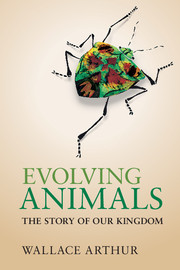Book contents
- Frontmatter
- Dedication
- Contents
- Preface
- Acknowledgements
- 1 What is an animal?
- 2 Before there were animals
- 3 How to make a fossil
- 4 The Cambrian explosion
- 5 How to make a species
- 6 Jellyfish and their kin
- 7 How to make a tree
- 8 The enigmatic urbilaterian
- 9 Animal symmetry and heads
- 10 A plethora of worms
- 11 Trends in animal complexity
- 12 Where the octopus is king
- 13 How to make an animal
- 14 Exoskeletons galore
- 15 Extinction
- 16 Mouth first, mouth second
- 17 Comparing embryos
- 18 Larvae, mouthparts and moulting
- 19 The animal toolkit
- 20 Vertebrate origins and evolution
- 21 From water to land to water
- 22 Variation and inheritance
- 23 Evolutionary novelties
- 24 Human origins and evolution
- 25 Animal plasticity
- 26 The nature of adaptation
- 27 The direction of evolution
- 28 Animal extremophiles
- 29 Extraterrestrial animals?
- 30 The ghost in the machine
- Appendix
- References
- Index
10 - A plethora of worms
Published online by Cambridge University Press: 05 August 2014
- Frontmatter
- Dedication
- Contents
- Preface
- Acknowledgements
- 1 What is an animal?
- 2 Before there were animals
- 3 How to make a fossil
- 4 The Cambrian explosion
- 5 How to make a species
- 6 Jellyfish and their kin
- 7 How to make a tree
- 8 The enigmatic urbilaterian
- 9 Animal symmetry and heads
- 10 A plethora of worms
- 11 Trends in animal complexity
- 12 Where the octopus is king
- 13 How to make an animal
- 14 Exoskeletons galore
- 15 Extinction
- 16 Mouth first, mouth second
- 17 Comparing embryos
- 18 Larvae, mouthparts and moulting
- 19 The animal toolkit
- 20 Vertebrate origins and evolution
- 21 From water to land to water
- 22 Variation and inheritance
- 23 Evolutionary novelties
- 24 Human origins and evolution
- 25 Animal plasticity
- 26 The nature of adaptation
- 27 The direction of evolution
- 28 Animal extremophiles
- 29 Extraterrestrial animals?
- 30 The ghost in the machine
- Appendix
- References
- Index
Summary
In the introductory chapter, we looked at the structure of the animal kingdom in terms of the relative numbers of species belonging to different groups. There, we concentrated in particular on the relative numbers of vertebrate and invertebrate species; and we saw that vertebrates make up less than 5% of the animal kingdom. Here, we pursue the theme of the make-up of the animal kingdom further, but from a different perspective: not the proportion of it that is vertebrate but the proportion that is vermiform – or worm-like.
However, this issue is not as simple as it seems. There are many different ways of assessing the size of any particular group of animals. Also, as we have seen already, there are many different ways of defining ‘group’, especially in the light of Darwin’s ‘groups within groups’ picture, for which he gave a mechanistic explanation – evolution. Prior to Darwin, the groups-within-groups view had probably been held by all serious students of zoology, and had been formalized by the Swede Carl Linnaeus – for plants as well as animals – way back in 1735.
- Type
- Chapter
- Information
- Evolving AnimalsThe Story of our Kingdom, pp. 94 - 103Publisher: Cambridge University PressPrint publication year: 2014



